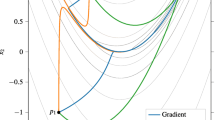Abstract
Saddle point linear systems arise in many applications in computational sciences and engineering such as finite element approximations to Stokes problems, image reconstructions, tomography, genetics, statistics, and model order reductions for dynamical systems. In this paper, we present a least-squares approach to solve saddle point linear systems. The basic idea is to construct a projection matrix and transform a given saddle point linear system to a least-squares problem and then solve the least-squares problem by an iterative method such as LSMR: an iterative method for sparse least-squares problems. The proposed method rivals LSMR applied to the original problem in simplicity and ease to use. Numerical experiments demonstrate that the new iterative method is efficient and converges fast





Similar content being viewed by others
References
Benzi, M., Golub, G.H., Liesen, J.: Numerical solution of saddle point problems. Acta Numer. 14, 1–137 (2005)
Boyd, S., Vandenberghe, L.: Convex Optimization. Cambridge University Press, Cambridge (2004)
Davis, T., Hu, Y.: The University of Florida sparse matrix collection. ACM Trans. Math. Softw. 38(1), 1–25 (2011)
Estrin, R., Greif, C.: On nonsingular saddle-point systems with a maximally rank deficient leading block. SIAM J. Matrix Anal. Appl. 36(2), 367–384 (2015)
Fong, D.C., Saunders, M.A.: LSMR: An iterative algorithm for sparse least-squares problems. SIAM J. Sci. Comput. 33(5), 2950–2971 (2011)
Golub, G.H., Kahan, W.: Calculating the singular values and pseudo-inverse of a matrix. SIAM J. Numer. Anal. 2, 205–224 (1965)
Golub, G.H., Van Loan, C.F.: Matrix Computations, 4th edn. Johns Hopkins University Press, Baltimore (2013)
Maryska, J., Rozlozník, M., Tuma, M.: The potential fluid problem and the convergence rate of the minimum residual method. Numer. Linear Algebra Appl. 3, 525–542 (1996)
Nocedal, J., Wright, S.: Numerical Optimization, 2nd edn. Springer, Berlin (2006)
Paige, C.C., Saunders, M.A.: LSQR: an algorithm for sparse linear equations and sparse least squares. ACM Trans. Math. Softw. 8(1), 43–71 (1982)
Pearson, J.W., Pestana, J., Silvester, D.J.: Refined saddle-point preconditioners for discretized Stokes problems. Numer. Math. 138(2), 331–363 (2018)
Pestena, J., Rees, T.: Null-space preconditioners for saddle point systems. SIAM J. Matrix Anal. Appl. 37(3), 1103–1128 (2015)
Reid, N.: Saddle point methods and statistical inference. Statist. Sci. 3(2), 213–227 (1988)
Song, Y., Yuen, X., Yue, H.: An inexact Uzawa algorithmic framework for nonlinear saddle point problems with applications to elliptic optimal control problem. SIAM J. Numer. Anal. 57(6), 2656–2684 (2019)
Wu, S.L., Salkuyeh, D.: A shift-splitting preconditioner for asymmetric saddle point problems. Comput. Appl. Math. 39(4), 314 (2020)
Yang, A.L., Li, X., Wu, Y.J.: On semi-convergence of the uzawa-hss method for singular saddle-point problems. Appl. Math. Comput. 252, 88–98 (2015)
Acknowledgements
The authors would like to thank the anonymous referees for their constructive comments and suggestions that improve the paper.
Author information
Authors and Affiliations
Corresponding author
Additional information
Publisher's Note
Springer Nature remains neutral with regard to jurisdictional claims in published maps and institutional affiliations.
Supported in part by NSF grants DMS-1719620 and DMS-2009689.
About this article
Cite this article
Karaduman, G., Yang, M. & Li, RC. A least squares approach for saddle point problems. Japan J. Indust. Appl. Math. 40, 95–107 (2023). https://doi.org/10.1007/s13160-022-00509-y
Received:
Revised:
Accepted:
Published:
Issue Date:
DOI: https://doi.org/10.1007/s13160-022-00509-y




